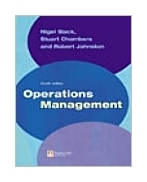|
||
• wydawnictwa polskie
• Zamów informacje o nowościach z wybranego tematu • kontakt
• Cookies na stronie |
OPERATIONS MANAGEMENT 4EDSLACK N., CHAMBERS S., JOHNSTON R.wydawnictwo: FT/PH , rok wydania 2004, wydanie IVcena netto: An essential tool for those wanting balanced coverage of services and manufacturing operations management. For Operations Management courses at both undergraduate and graduate level. This book is intended to
provide an introduction to operations management for all students who wish to understand
the nature and activities of operations management. Providing a clear, This book strikes an interesting balance between the strategic and operational views of operations management and between manufacturing and service industry views of operations. Nigel Slack's Operations Management is THE authoritative, managerial view of the subject. The text outlines the importance of operations and demonstrates how crucial it is in creating the products and services upon which we all depend. This revised and fully updated edition of Operations Management continues to provide a clear, well-structured and comprehensive treatment of the subject, balancing a logical approach with the insights that come from real life operations examples and practices around the world. Features The authoritative managerial view of operations management A good balance between strategic and operations, and service and manufacturing views of operations management that offers students a wider outlook on operations management Clear structure based on design, planning and control, and improvement, which makes core concepts easier to follow Fantastic full-colour design with colour, exercises and images illustrating concepts and examples throughout Key questions to open each chapter with answers at the end of each chapter, provoke class discussions and enable students to pick up on the key points Global examples and cases with questions (full length mini-cases), offer a international perspective on operations management Key terms and glossary enable students to fully understand the terms used throughout the text Critical commentary boxes ensure that students are able to follow and understand the issues surrounding each chapter Worked examples come in both qualitative and quantitative techniques - demonstrates to students how these techniques can be used Study activities enable students to actively learn Extensive support for both students and lecturers online at www.booksites.net/Slack Table of Contents Preface 1. Operations management 4. Process design Glossary 794 pages
Po otrzymaniu zamówienia poinformujemy, |


